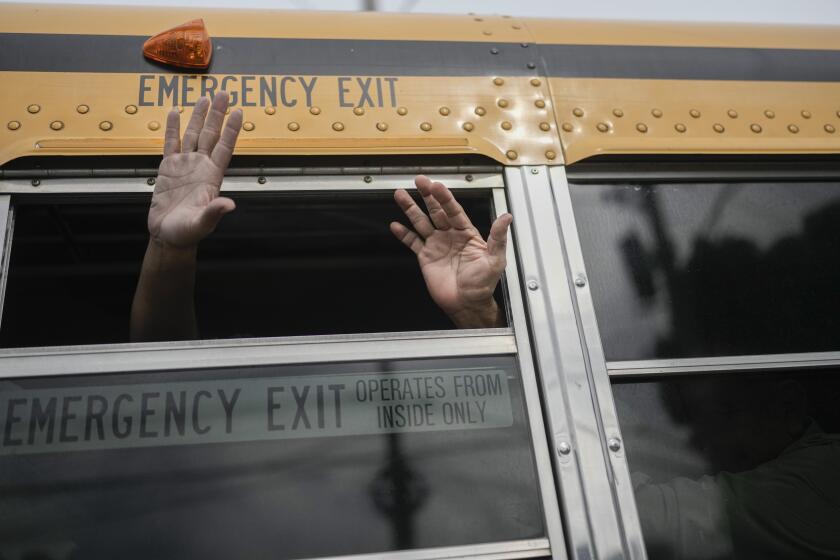Some Hospitals Giving Up Hope
Only four babies were born at Santa Teresita Hospital in Duarte in November. Even for a tiny 39-bed hospital, four babies isn’t good -- not when there are salaries to pay and bills piling up.
It was only one sign of the hospital’s fiscal pain. Two weeks ago, instead of hiring more nurses as required by a new state law, administrators decided to shut down the 49-year-old acute facility altogether.
“It was a losing battle for us,” said Sister Michelle Clines, chairwoman of the facility, which may continue to operate as a clinic. “We didn’t want to go bankrupt.”
The number of hospitals has been in decline for years in the state. In the last decade, 60 have closed while only 26 have opened, according to the state Department of Health Services.
But some health industry officials and experts expect the trend to accelerate as hospitals scramble to meet the requirements of two costly state laws, which require minimum nurse staffing levels and seismic improvements.
“There is no question in my mind that the smaller hospitals will have to close programs or close their doors because they won’t have the money to meet the law and serve their patients,” said Bob Reed, chief financial officer for the Sutter chain of hospitals in Northern California. “Some will decide to exit the business.”
Although some officials say hospitals could benefit from some pruning or consolidation, residents in affected communities decry the loss of nearby emergency services and secure jobs.
Santa Teresita was one of three hospitals in Southern California to announce their closure in the last month, joining Santa Paula Memorial in Ventura County and Century City Hospital in Los Angeles. A fourth hospital -- Trinity General in rural Northern California -- may soon close if area residents can’t muster more than $1 million to fix a leaky roof.
In the previous two years, closures included Granada Hills Community Hospital in the San Fernando Valley and St. Luke’s Medical Center in Pasadena.
The new laws add to the many woes that hospital administrators say they are already facing: paltry Medi-Cal and Medicare payments, pinched managed-care rates and the soaring cost of technology.
“Our total volume was 65% Medicare and Medi-Cal and another 15% to 20% managed care, and they all pay terrible,” said Gene Kaberline, chief financial officer at Santa Paula Memorial.
He said the facility was recouping only 30 to 35 cents of every dollar it was spending -- and that was before the hospital suffered a nursing shortage last year that forced it to pay huge sums to fill staffing gaps. By December, Kaberline said, vendors were demanding cash payment from the hospital -- cash that it didn’t have.
Especially in more isolated or rural areas, hospitals often do not have enough patients, leaving many beds empty.
Trinity General in Weaverville is $2.4 million in the red and losing $10,000 a day. Asked how long the county-owned facility has suffered money troubles, Trinity County counsel David Hammer replied, “Forever.”
Procedures that once required hospital stays -- such as cataract surgery, biopsies and dialysis -- can now be done at outpatient clinics. Some mothers are going home the day after giving birth.
As expenses climb, hospitals need patients to generate income and survive.
The dagger through the heart of Santa Teresita was the new law on nurse-to-patient ratios that took effect Jan. 1, officials said. California, with one of the worst nursing shortages in the nation, was the first state to require minimum nurse staffing levels.
Many hospital officials said that to meet the ratios at all times of the day -- as the law requires -- they must find a way to hire and pay additional nurses.
Clines said Santa Teresita was already facing financial shortages and a monthly payroll of $1 million. Officials were reluctant to add staff or pay bonuses to lure nurses to the hospital.
“We didn’t want to stand around and wait for the penalties to come in for being in noncompliance with the law,” she said.
Others say hospital administrators are exaggerating their claims that meeting nurse ratios is too burdensome.
Charles Idelson, spokesman for the California Nurses Assn., a labor union that represents 55,000 nurses in the state, said those claims are part of “a heavy-handed campaign by the hospital industry to sabotage California safe staffing law.”
Gerald Kominski, an associate director of UCLA’s Center for Health Policy Research, says the latest available data, from 2002, indicates that hospital profits are as high as they have been in the last 10 to 15 years.
“This is, relatively speaking, a relatively profitable time,” he said. “It doesn’t mean individual hospitals are not struggling. It also doesn’t mean the regulations aren’t causing hospitals to be squeezed more than they would be otherwise. To say this is causing the industry severe financial threat sounds to me like an overstatement.”
Hospitals in California also are struggling to meet a 2008 deadline to prevent their buildings from collapsing in an earthquake. By 2030, hospitals must retrofit their buildings to make sure they can also function in a major temblor.
The deadline was set in 1994, after the Northridge earthquake. But so far no hospital in the state has finished the retrofitting. About 150 have been granted extensions until 2013.
Many hospital officials decry the seismic program, which they call an “unfunded mandate” because the state isn’t helping pay for it.
“Our estimated cost for [retrofitting] is going to be in excess of $200 million,” said Chris Van Gorder, president and CEO of Scripps Health, which operates five hospitals in San Diego County. “Obviously, you don’t have $200 million if you’re not generating a margin.”
Last week, Scripps officials said they would terminate contracts to treat Medi-Cal patients at their hospitals in La Jolla and Encinitas because reimbursements were so low. That triggered a 120-day negotiating period.
Southern Inyo Hospital in Lone Pine, in the Owens Valley, is one of the hospitals struggling to pay for a seismic upgrade. It is the only hospital in a 140-mile stretch between Bishop and Ridgecrest. The hospital doesn’t see enough patients to keep it afloat. In fact, its revenue is generated from a 33-bed skilled nursing facility.
To help pay for the retrofit, the hospital has joined a consortium of 12 other small hospitals hoping to use their combined buying power to reduce the cost.
For tiny Trinity General in Weaverville, seismic upgrades are the least of its concerns.
In December, water from a plugged-up gutter took out a chunk of ceiling above the facility’s emergency room and waiting area. The leak badly damaged walls and water sometimes oozed from vents, according to a state inspection report from Dec. 31.
The leaks have since been patched, but Trinity County -- which runs the hospital -- cannot afford to replace the roof, which is rotting and is the source of the water problem. The state has said it would shut the hospital unless a plan for the repair is submitted next month.
At a meeting this week of the Board of Supervisors, attended by about 350 residents, many said the region cannot afford to lose the troubled hospital.
The nearest emergency room is 45 miles away in Redding, down a twisting road. Residents and advocates for rural health care worry that could mean accident victims or others in dire need of help will literally expire on the highway.
“You can’t put a whole ER in an ambulance,” said Dr. Robert Derlet, a professor of emergency medicine at UC Davis.
Trinity County counsel Hammer said officials aren’t even thinking about the seismic retrofits.
“There’s no way in the world a hospital like our hospital can do that,” Hammer said. “It would be cheaper to build a new hospital for $20 million. If the county was not floating the debt of the hospital, the hospital would be closed. It doesn’t have the funds to make payroll even today.”
More to Read
Sign up for Essential California
The most important California stories and recommendations in your inbox every morning.
You may occasionally receive promotional content from the Los Angeles Times.










